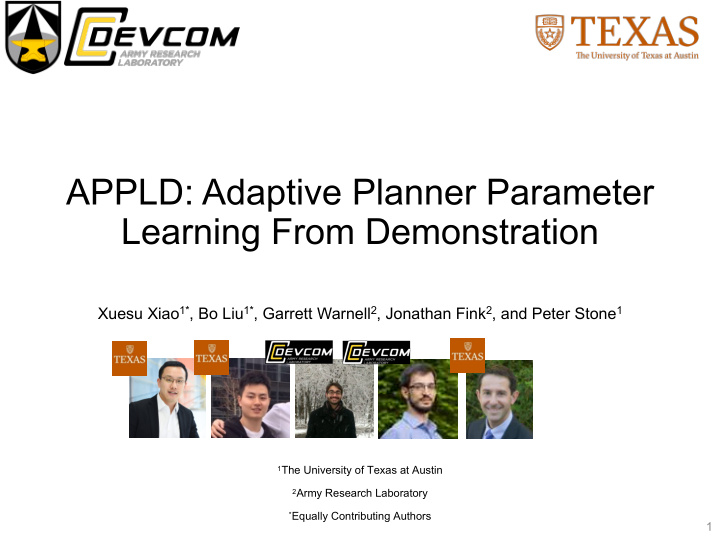



APPLD: Adaptive Planner Parameter Learning From Demonstration Xuesu Xiao 1* , Bo Liu 1* , Garrett Warnell 2 , Jonathan Fink 2 , and Peter Stone 1 1 The University of Texas at Austin 2 Army Research Laboratory * Equally Contributing Authors 1
LfD for Improved Robot Navigation Motivation: Deploying an autonomous navigation system in a new environment is not as straightforward as it may seem. 2
LfD for Improved Robot Navigation Inspiration: Humans do this effortlessly. 3
LfD for Improved Robot Navigation Central Question: Can we squeeze more robust performance out of our existing navigation systems using LfD and limited human interaction? LfD? ROS move_base navigation stack 4
LfD for Improved Robot Navigation Proposed : Use behavioral cloning to “tune” any navigation stack. tuning parameters sensor data motor commands Behavioral Cloning : Learn parameters from a demonstration using supervised learning. 5
LfD for Improved Robot Navigation Context Problem: Humans exhibit qualitatively different navigation behaviors in qualitatively different environments. 6
LfD for Improved Robot Navigation APPLD: Adaptive planner parameter learning from demonstration 1. Collect demonstration. 2. Perform automatic demonstration segmentation. 3. Use black-box optimization to find set of optimal parameters. 4. Use supervised learning to train a context predictor. 7
LfD for Improved Robot Navigation APPLD Deployment 8
LfD for Improved Robot Navigation Experiments Robot : Clearpath Jackal (Velodyne Puck lidar) Human : An author (Xbox wireless controller) Environment : Challenging obstacle course 9
Results APPLD: Deployment in demonstration environment 10
Results Xuesu Xiao xiao@cs.utexas.edu Different robot, navigation stack, and environment 11
Recommend
More recommend